

History for Kids: Aztecs, Maya, and Inca. Back to History.
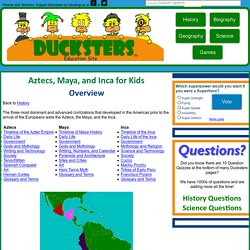
History's Turning Points - The Conquest of the Incas Part 2/3. History's Turning Points - The Conquest of the Incas Part 3/3. History's Turning Points - The Conquest of the Incas Part 1/3. HISTORY OF THE INCAS. Cuzco and the Incas: 15th century In the early 15th century the town of Cuzco is a small place, the headquarters of one of many competing tribes within the region which was once ruled from Tiwanaku.

But in about 1438 a younger son of the ruler defeats the neighbouring Chanca people, usurps power, gives himself the resounding title Pachacuti ('transformer of the earth') and begins an astonishing process of military expansion. The policy is continued by his son, Topa Inca (also sometimes called Tupac Inca). By the end of two long reigns (about fifty-five years in all) the Cuzco dynasty, known as the Incas, are in loose control of an empire stretching from Quito in modern Ecuador to the Maule river in Chile - a distance of nearly 2500 miles.
Even allowing for the exaggerations of oral history transmitted within a ruling dynasty, this is a remarkable achievement. The Inca expansion also shares some features with Genghis Khan's programme of conquest. Inca roads: 15th century. The Conquest of Peru and the Inca Empire. Incas - HowStuffWorks. Incas, an Indian people of South America.
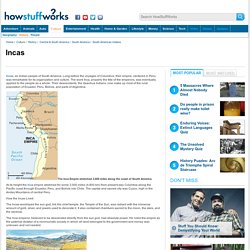
Long before the voyages of Columbus, their empire, centered in Peru, was remarkable for its organization and culture. The word Inca, properly the title of the emperors, was eventually applied to the people as a whole. Their descendants, the Quechua Indians, now make up most of the rural population of Ecuador, Peru, Bolivia, and parts of Argentina. Prehistoric Inca neurosurgery – Neurophilosophy. The procedure known as trepanation, in which a hole is scraped or drilled in the skull, is an ancient form of neurosurgery that has been performed since the late Stone Age.

Exactly why ancient peoples performed trepanation has remained a matter of debate: some researchers argue that it was performed for medical reasons, as it is today, while others believe it was done for magical or religious reasons. A new study by two American anthropologists now provides evidence that the Incas performed trepanation to treat head injuries; that the procedure was far more common than was previously thought; and that the Incan practitioners of trepanation were highly skilled surgeons with a detailed knowledge of the anatomy of the skull. Of these 411 skulls, 66 exhibited perforations of varying shape and size. More than half were circular, but some were oval or irregularly circular, and one (above) was rectangular. The diameters of the circular holes ranged from approximately 0.3 – 7.3 cm.
Exploring the Inca Heartland: Machu Picchu. We wandered down a long stretch of Inca road from the Sun Gate, enjoying the view of the site below us and feeling good about having hiked the Inca Trail.
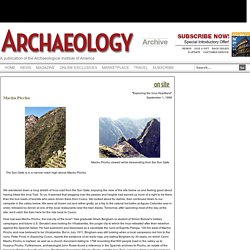
To us, it seemed that slogging over the passes and heights had earned us more of a right to be there than the bus loads of tourists who were driven there from Cusco. We looked about for awhile, then continued down to our campsite in the valley below. We were all blown out and rather grotty, so a trip to the natural hot baths at Aguas Calientes was in order, followed by dinner at one of the local restaurants near the train tracks. Tomorrow, after spending most of the day at the site, we'd catch the train here for the ride back to Cusco.
How lost was Machu Picchu, the lost city of the Inca? The Incas. The Incas The Incas, an American Indian people, were originally a small tribe in the southern highlands of Peru.

In less than a century, during the 1400s, they built one of the largest, most tightly controlled empires the world has ever known. Their skill in government was matched by their feats of engineering. Inca Facts, information, pictures. Inca (Ĭng´kə), pre-Columbian empire, W South America.
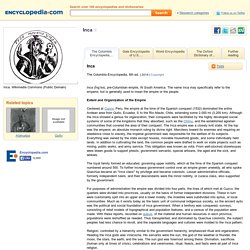
Inca Skull Surgeons Were "Highly Skilled," Study Finds. May 12, 2008 Inca surgeons in ancient Peru commonly and successfully removed small portions of patients' skulls to treat head injuries, according to a new study.
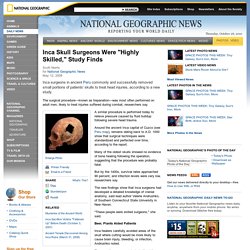
The surgical procedure—known as trepanation—was most often performed on adult men, likely to treat injuries suffered during combat, researchers say. A similar procedure is performed today to relieve pressure caused by fluid buildup following severe head trauma. Around the ancient Inca capital of Cuzco (see Peru map), remains dating back to A.D. 1000 show that surgical techniques were standardized and perfected over time, according to the report. Inca mathematics. Version for printing It is often thought that mathematics can only develop after a civilisation has developed some form of writing.
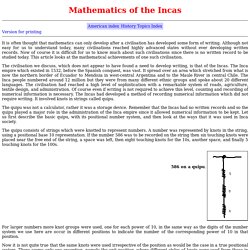
Although not easy for us to understand today, many civilisations reached highly advanced states without ever developing written records. Now of course it is difficult for us to know much about such civilisations since there is no written record to be studied today. Viracocha And The Coming Of The Incas. Sacred Texts Native American Index Previous Next from "History of the Incas" by Pedro Sarmiento De Gamboa, translated by Clements Markham, Cambridge: The Hakluyt Society 1907, pp. 28-58.
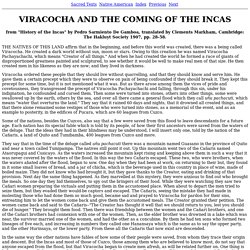
THE NATIVES OF THIS LAND affirm that in the beginning, and before this world was created, there was a being called Viracocha. He created a dark world without sun, moon or stars. Owing to this creation he was named Viracocha Pachayachachi, which means "Creator of all things. " And when he had created the world he formed a race of giants of disproportioned greatness painted and sculptured, to see whether it would be well to make real men of that size.
National Geographic. Steeped in death, conquest, desire, and mystery, the legend of the lost Inca gold is guarded by remote, mist-veiled mountains in central Ecuador. Somewhere deep inside the unforgiving Llanganates mountain range between the Andes and the Amazon is said to exist a fabulous Inca hoard hidden from Spanish conquistadors. The legend begins in the 16th century, when the great Inca Empire in western South America was giving way to European invaders. Quechua Language and the Quechua (Inca) Indians (Quichua, Inga, Runasimi) Inca Empire Timeline and King List. Timeline and Kinglist of the Inca Empire The Inca word for ruler was 'capac', or 'capa', and the next ruler was chosen both by heredity and by marriage lines. All of the capacs were said to be descended from the legendary Ayar siblings (four boys and four girls) who emerged from the cave of Pacaritambo.
The first Inca capac, the Ayar sibling Manco Capac, married one of his sisters and founded Cusco. The ruler at the height of the empire was Inca Yupanqui, who renamed himself Pachacuti (Cataclysm) and ruled between AD 1438-1471. Most scholarly reports list the date of the Inca empire as beginning with Pachacuti's rule. High status women were called 'coya', and how well you could succeed in life depended to a degree on the genealogical claims of both your mother and father. Calendrical dates for the reigns of the various kings were established by Spanish chroniclers based on oral histories, but they are clearly miscalculated and so are not included here. People. Inca, also spelled Inka, South American Indians who, at the time of the Spanish conquest in 1532, ruled an empire that extended along the Pacific coast and Andean highlands from the northern border of modern Ecuador to the Maule River in central Chile. The Inca established their capital at Cuzco (Peru) in the 12th century.
They began their conquests in the early 15th century and within 100 years had gained control of an Andean population of about 12,000,000 people. See also pre-Columbian civilizations: The Inca. Aztec, Maya & Inca foods. Quipu - Ancient Writing System of the Incas. The Inca writing system called quipu (also spelled khipu or quipo) is the only known precolumbian writing system in South America—well, perhaps writing system isn't quite the correct phrase.
But quipus were clearly an information transmittal system, and not just for the Inca. Instead of a clay tablet impressed with triangles like cuneiform, or a piece of paper with symbols written on it like Egyptian hieroglyphs, a quipu is essentially a collection of wool and cotton strings tied together, a knotted page of information which could be easily transported and easily translated across the wide expanses of South America. While scholars have yet to translate the quipu, we do know that information was embedded in the quipu in a number of different ways. Inca Architecture at Machu Picchu. Inca religion. Inca Road System Construction and Lodging. The Inca road system (called Capaq Ñan in Quechua and Gran Ruta Inca in Spanish) was an essential part of the success of the Inca Empire. The road system included an astounding 40,000 kilometers (25,000 miles) of roads, bridges, tunnels and causeways.
Road construction began in the mid-fifteenth century when the Inca gained control over its neighbors and started expanding its empire; it ended abruptly 125 years later when the Spanish arrived in Peru. As a contrast, the Roman Empire built twice as many miles of road, but it took them 600 years. Four Roads from Cuzco. The Lost Inca Empire. Economy, Architecture and Religion of the Inca. Beginner's Guide to the Inca Empire. P B S : C o n q u i s t a d o r s - P i z a r r o. The Inca and Their Roads. Now primarily a tourist attraction, Inca roads were once the arteries of a mighty Empire. Spanning a the continent lengthwise, the Inca road network covered approximately 22,000 miles of roads and trails with about half of that paved. They built stone surfaced roads where the terrain required it, but merely marked the way and distance on dessert or flat coastal terrain. An Overview of Inca Tech. Geography Drives Technology The Incas inherited an unforgiving geographic landscape.
Despite its overwhelming beauty, its various terrains held hazards and risks.